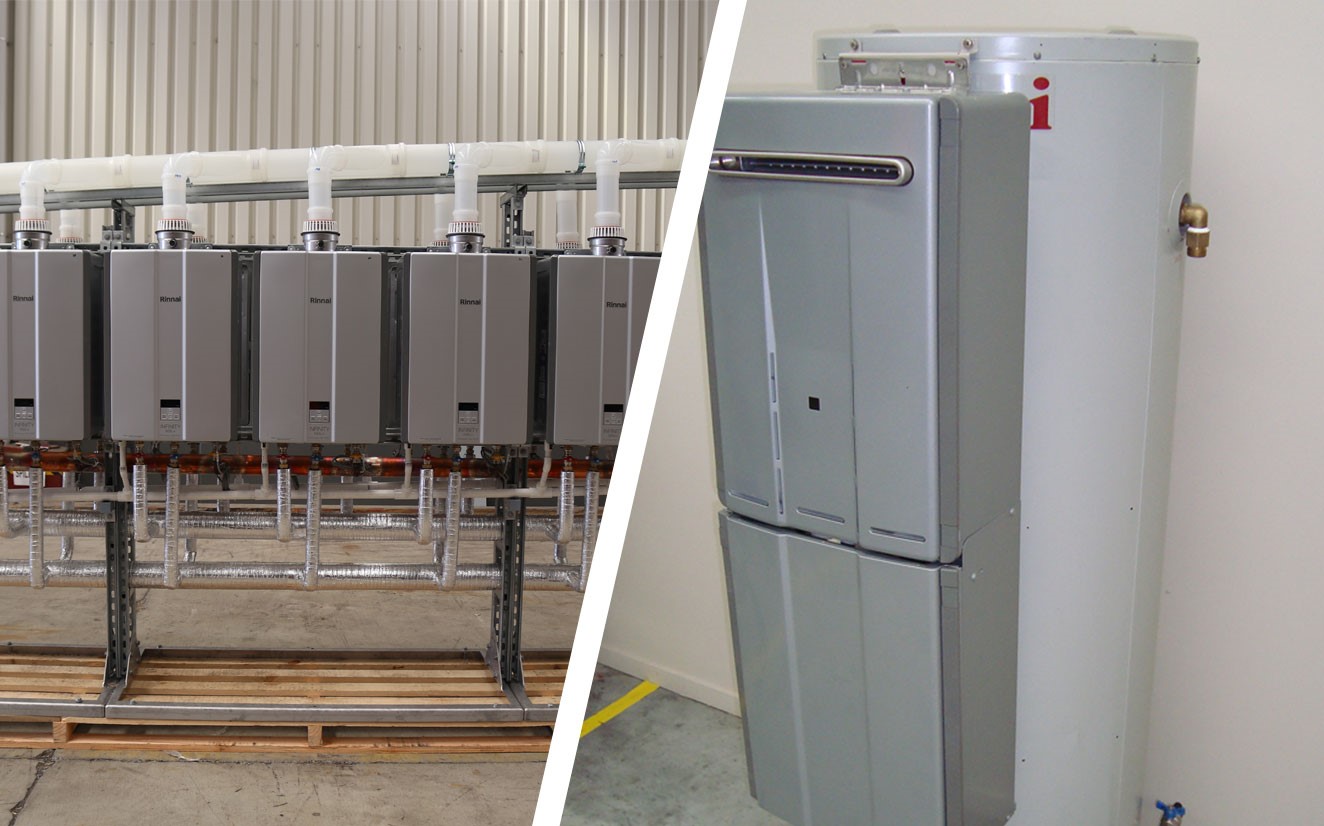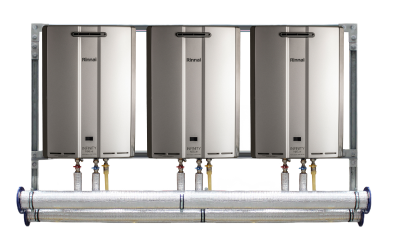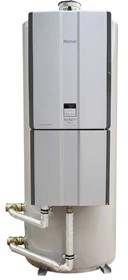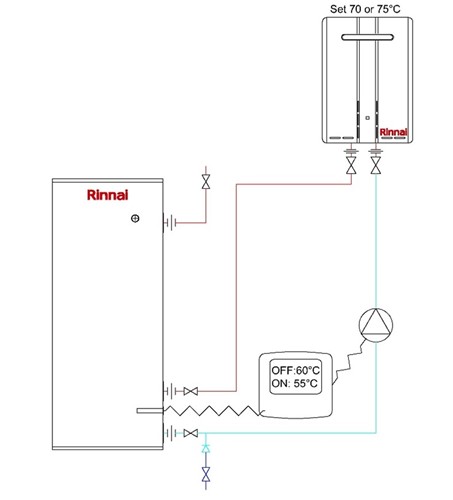
Rinnai has two types of systems for larger domestic and commercial potable hot water applications:
This article gives an overview of the two systems and some guidance on which to select for your application.

The control board of each Rinnai INFINITY® connects to the others in the set. One unit is designated as “primary” with the others as “secondary”. Up to twenty-five units can be connected, giving an output of over 1400 kW.
When there is no hot water demand, the system selects a unit to be on standby with its internal water flow control valve in the open position. The other units fully close their water flow valves. When a hot tap is turned on, the system opens the water flow valves of additional units as required to meet demand.
Operating units are rotated so all units have equal time operating, which increases the economic life of the Rinnai INFINITIES® and reduces maintenance. In the unlikely event that a unit experiences a fault, that unit will fully close its water flow valve and the system will select another boiler to operate.
A single temperature controller can be connected to the primary unit which will control the temperature of the entire system.

A Rinnai INFINITY® is certified for use as a potable water appliance. This makes them straightforward to combine with storage vessels. No calorifier coils or heat exchangers, filling loops, dosing pots, expansion chambers etc. are required.
A temperature sensor in the tank is connected to a pump controller. When the temperature in the tank drops to a determined level, the pump is started. The Rinnai INFINITY® detects the flow and heats the water. Once the temperature reaches the tank set temperature, the pump switches off. It is important to maintain a temperature differential between the Rinnai INFINITY® set point and the pump-off temperature. A minimum of 10°C differential is preferred. The usual settings are: Pump ON: 55°C, Pump OFF: 60°C, Rinnai INFINITY®: 70°C or 75°C.

Note: Only commercial model Rinnai INFINITIES® can be set to 70°C or higher. Setting the pump-OFF temperature at or close to the Rinnai INFINITY® set temperature will result in high wear and maintenance costs.
There are four main decision criteria. If any of these criteria suggest a fast-recovery storage system then that is probably the best option
If the customer is connected to a reticulation system and the site piping has sufficient capacity then multiple continuous flow systems can be considered.
Where the customer plans to use 45kg cylinders, up to 3 Rinnai INFINITIES® can be run simultaneously if a suitably certified electric blanket is fitted to a single cylinder. See https://vaporgas.co.nz/products/vapor-booster/.
Where more than 2 x 45kg cylinders are needed then a site location certificate may be required. This will require an annual inspection for renewal.
A fast recovery storage system limits peak gas use and may allow a system to operate on an LPG twin-pack.
Rinnai continuous flow water heaters need a minimum of 200 – 300 kPa to operate a full capacity. If a system is required to operate on low water pressure then a Rinnai Demand Rapid fast-recovery storage system may be preferable.
Identifying the pattern of water use is important: is it lots of very small draws (e.g. toilets at a theatre) or few long draws (e.g. all the showers at a school dormitory run for 20 minutes)?
A large number of very small hot water draws is suited to a system incorporating storage. Long high draws are usually best handled by multiple Rinnai INFINITIES®. Short, high flow rate draws are bread and butter for the Demand Rapid fast-recovery storage system – this is why you will find it in many launderettes in New Zealand.
In hotels and apartment buildings, a combination of multiple Rinnai INFINITIES® and storage is usually selected. The peak hour water use is matched to the number of Rinnai Infinities. Storage equivalent to 20% of the peak hour is provided to supply any short-term peak loads that might occur in the peak hour.
Surprisingly, sometimes running out of hot water can be a good thing! For example, in rugby clubs with common shower areas, it is not uncommon for a group of players to stand under the shower for a long time until the hot water runs out. If the club had multiple Rinnai INFINITIES®, the water will not run out but create a very high gas (and water) bill for a club that may be of limited means. In these cases, the best solution might be a fast recovery storage system carefully sized to provide a reasonable volume of hot water and with sufficient input to ensure hot water is available when the next team comes off the field.
When it is absolutely essential that hot water never runs out, then multiple Rinnai INFINITIES® are the answer.
Remember that a fast-recovery storage system is relying on the circulating pump operating to drive water through the attached Rinnai INFINITY®. We strongly recommend dual pumps are used in commercial accommodation applications and anywhere else hot water is mission critical. Without this you are only a pump failure away from no hot water.
For assistance in selecting your next large domestic or commercial hot water system, please contact the Rinnai commercial hot water team on 0800 RINNAI (0800 746 642).